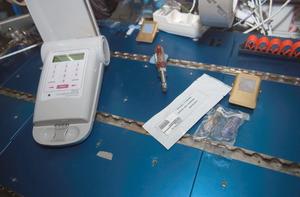
The ISS Starboard S6 Truss-section was analyzed with LOCAD-PTS in October 2008 and December 2008-while located in the Space Station Processing Facility (SSPF) at NASA's Kennedy Space Center-and again in space following launch of Space Shuttle Discovery STS-119. The LOCAD-PTS Exploration experiment has been funded by NASA's Science Mission Directorate (SMD), under the Moon and Mars Analogue Mission Activities (MMAMA) Program, and is the first SMD-funded experiment aboard the ISS. The goal of the experiment is to design and test procedures to monitor and document the spread of biological material associated with human spaceflight, both before and after launch, in preparation for the human exploration of the Moon and Mars. It is a collaboration between BAE Systems, Charles River Laboratories (CRL), NASA Johnson Space Center (Astronaut Office, Crew and Thermal Systems Division, and Extravehicular Activity (EVA) and Crew Survival Systems Branch), NASA Kennedy Space Center and NASA Marshall Space Flight Center. It is concluded that while a general correlation between LOCAD-PTS and traditional culture-based methods should not necessarily be expected, a combinatorial approach can be adopted where both sets of data are used together to generate a more complete story of the microbial ecology on the ISS.LOCAD-PTS Exploration is an ISS experiment funded by the Moon and Mars Analogue Mission Activities (MMAMA) Program of NASA's Science Mission Directorate.

A poster will be presented that describes a comparative study between LOCAD-PTS analysis and existing culture-based methods onboard the ISS together with an exploratory survey of surface endotoxin throughout the ISS.
#NASA LOCAD PORTABLE#
This handheld device and sampling system is known as the Lab-On-a-Chip Application Development Portable Test System (LOCAD-PTS). This technique involves analysis of environmental samples with the Limulus Amebocyte Lysate (LAL) assay in a handheld device. This report describes the operation of a new culture-independent technique onboard the ISS for rapid analysis (within minutes) of endotoxin and -1, 3-glucan, found in the cell walls of gram-negative bacteria and fungi, respectively.

However, the approach is also limited by the following: i) More than 95% microorganisms in the environment cannot grow on conventional growth media ii) Significant time lags occur between onboard sampling and colony visualization (3-5 days) and ground-based analysis (as long as several months) iii) Colonies are often difficult to visualize due to condensation within contact slide media plates and iv) Techniques involve growth of potentially harmful microorganisms, which must then be disposed of safely. This approach has provided a wealth of useful data and enhanced our understanding of the microbial ecology within space stations. These techniques involve growing environmental samples (cabin water, air or surfaces) on agar-type media for several days, followed by visualization of resulting colonies and return of samples to Earth for ground-based analysis. LOCAD-PTS: Operation of a New System for Microbial Monitoring Aboard the International Space Station (ISS) Microorganisms within the space stations Salyut, Mir and the International Space Station (ISS), have traditionally been monitored with culture-based techniques.


 0 kommentar(er)
0 kommentar(er)
